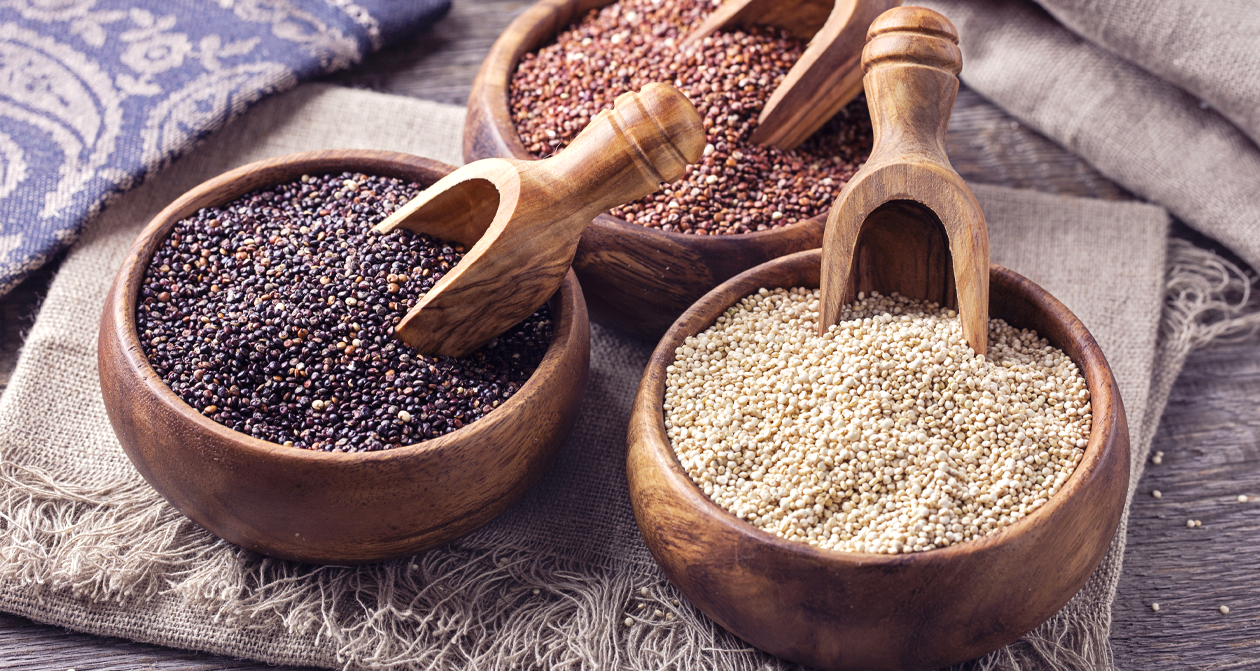
QUINOA. THE NUMBER ONE SUPERFOOD, A REAL POWERHOUSE.
Packed with nutrients, easy to digest and low in calories, quinoa is a real superfood and should be part of everyone’s diet. Quinoa is rich in proteins and mineral salts, it contains all the eight essential amino acids needed for protein synthesis, it has powerful anti-ageing properties and is also good for hair. It is these characteristics that have made it the new favourite food of health enthusiasts, vegetarians and vegans around the world. Up to a short time ago, you could only really buy it in health food shops, but now quinoa can be found on the shelves of our regular supermarkets, testimony of its popularity not only with a small group of consumers who are careful about what they eat. Is it a trend, an eccentric food fad or is there something more to quinoa? There certainly is something more to it, as the UN and the FAO declared 2013 the International Year of Quinoa. Why? In December 2011 the UN had recognised the exceptional nutritional properties and quality of this natural grain that should be preserved for present and future generations. A BIT OF HISTORY. Quinoa is native to South America and in particular to the mountainous Andes areas of Bolivia, Peru and Chile. The Incas used to call it chisiya mama, which in the Quechua language means “mother of all grains”, and they believed it to be sacred. In the 1970s and ’80s some American researchers successfully transplanted some samples in North America, giving this ancient crop a new lease of life. Now it is also grown in several areas of Italy. THE EXTRAORDINARY PROPERTIES OF QUINOA. Quinoa is not a cereal but a pseudo-cereal because although its chemical characteristics are similar to those of cereals – Gramineae or Poaceae – it actually belongs to a totally different family, the chenopodiaceae family, like beets and spinach. It is gluten free so suitable for coeliac sufferers. Essential amino acids. What sets quinoa apart from other grains is it contains all the essential amino acids needed for protein synthesis. There are twenty amino acids involved in protein synthesis and of these 20, 8 are essential (leucine, isoleucine and valine (BCAA), lysine, methionine, threonine, phenylalanine and tryptophan). Essential amino acids are amino acids which the human body cannot synthesize in large enough quantities for its needs. This means that since they are necessary but not synthesizable, we must obtain them through our diet or food supplements. An amino acid deficiency can lead to loss of muscle tone and also: - chronic tiredness and fatigue, because the body is not able to find the energy it needs; - fragile hair that is prone to falling out, as amino acids help produce hormones and synthesize keratin; - dermatitis, even the health of our skin is linked to protein metabolism; - osteoporosis, especially where there is an arginine deficiency which can affect how much calcium is fixed in bones. These deficiencies are often associated with an unbalanced diet due to an insufficient intake of animal proteins. Proteins. Quinoa has a high protein content. It contains around 13-15% proteins, more than any other known cereal. So more than corn, millet, wheat and rice. The proteins in our body are responsible for building and repairing muscle tissue, skin, nails, hair, cartilage and bones. Minerals. Quinoa is also rich in minerals, especially iron, which is essential for synthesizing haemoglobin and oxygenating the blood. Besides iron, it also contains high concentrations of potassium, magnesium, calcium, phosphorus and zinc. These substances all play a key role in our vital processes. Vitamins. Quinoa contains some fat-soluble B-complex vitamins such as tiamin (vit B1), riboflavin (vit B2), pantothenic acid (vit B5), pyridoxine (vit B6) and folates. Group B vitamins, for example, regulate the metabolism of the hair follicle. A serious deficiency can lead to greasy hair, dandruff and baldness. It is also a good source of vitamin E, a powerful antioxidant which keeps the brain young, slows down cell ageing, protects our sight and increases oxygen absorption in our body’s cells. An American study published in 2008 showed that quinoa also contains flavonoids, plant substances which fight free radicals very effectively. It contains in particular high amounts of kaempferol and quercetin, and its quercetin content is higher than that of foods like cranberries (which have always been considered an excellent source of quercetin). Finally, the complex carbohydrates in quinoa fuel our bodies with energy for longer than other cereals, as complex cereals take longer to break down, therefore providing a constant source of energy throughout the day. So it is ideal for athletes, anyone who enjoys regular exercise and those wanting to lose weight as it heightens the feeling of fullness. Quinoa really is a complete superfood and should be part of everyone’s diet, as it has exceptional nutritional properties that benefit our well-being and the health of our organism.  QUICK, DELICIOUS RECIPES WITH QUINOA. Here are two quick recipes that are perfect for lunch, a packed lunch or an instant energy boost! Before starting, you need to know how to cook quinoa. Follow these instructions for both the recipes below. First rinse the quinoa thoroughly in cold water and leave it to soak for about half an hour. This will remove the saponins and its slightly bitter taste. Then wash it again several times in cold water. In the meantime, put 2-3 parts water for every part of quinoa in a pan (so for 150 g of quinoa you will need about 300-400 ml of water). Salt the water and bring to the boil. When it is boiling, add the quinoa and let it boil for about 20 minutes. Summer salad. Serves two. 150 g quinoa 1 green pepper 1 cucumber 2 carrots 1 courgette Extra virgin olive oil Lemon juice Sea salt Oregano Wash and cook the quinoa following the instructions above. Cut the cucumber into small pieces, the carrots and pepper into thin strips and the courgette into cubes. You can use either raw or cooked vegetables in this recipe. After the quinoa has cooked for 20 minutes, strain it under cold running water just as you would for a rice salad. Add the vegetables and season with olive oil, lemon juice and oregano. You can use different vegetables according to seasonal availability and your own personal tastes. Add mozzarella or tofu. Vegetarian paella with quinoa. Use quinoa instead of rice to make a completely vegetable paella. This recipe serves four. 300 g quinoa 40 g boiled peas Extra virgin olive oil Sea salt Powdered turmeric 3 garlic cloves 2 red peppers 2 courgettes 1 onion Wash and cook the quinoa following the instructions above, adding two spoonfuls of powdered turmeric to the water. Leave the quinoa to cook for 20 minutes. Cut the vegetables into small pieces and cook them in a frying pan with a drop of oil. Add the boiled peas and the cooked and strained quinoa. Mix well then sauté in the pan on a high flame and serve.
QUICK, DELICIOUS RECIPES WITH QUINOA. Here are two quick recipes that are perfect for lunch, a packed lunch or an instant energy boost! Before starting, you need to know how to cook quinoa. Follow these instructions for both the recipes below. First rinse the quinoa thoroughly in cold water and leave it to soak for about half an hour. This will remove the saponins and its slightly bitter taste. Then wash it again several times in cold water. In the meantime, put 2-3 parts water for every part of quinoa in a pan (so for 150 g of quinoa you will need about 300-400 ml of water). Salt the water and bring to the boil. When it is boiling, add the quinoa and let it boil for about 20 minutes. Summer salad. Serves two. 150 g quinoa 1 green pepper 1 cucumber 2 carrots 1 courgette Extra virgin olive oil Lemon juice Sea salt Oregano Wash and cook the quinoa following the instructions above. Cut the cucumber into small pieces, the carrots and pepper into thin strips and the courgette into cubes. You can use either raw or cooked vegetables in this recipe. After the quinoa has cooked for 20 minutes, strain it under cold running water just as you would for a rice salad. Add the vegetables and season with olive oil, lemon juice and oregano. You can use different vegetables according to seasonal availability and your own personal tastes. Add mozzarella or tofu. Vegetarian paella with quinoa. Use quinoa instead of rice to make a completely vegetable paella. This recipe serves four. 300 g quinoa 40 g boiled peas Extra virgin olive oil Sea salt Powdered turmeric 3 garlic cloves 2 red peppers 2 courgettes 1 onion Wash and cook the quinoa following the instructions above, adding two spoonfuls of powdered turmeric to the water. Leave the quinoa to cook for 20 minutes. Cut the vegetables into small pieces and cook them in a frying pan with a drop of oil. Add the boiled peas and the cooked and strained quinoa. Mix well then sauté in the pan on a high flame and serve.


Validate your login
Sign In
Registrati a "Medavita Salon Friends" e ricevi vantaggi e promozioni per i servizi in salone.
Create New Account